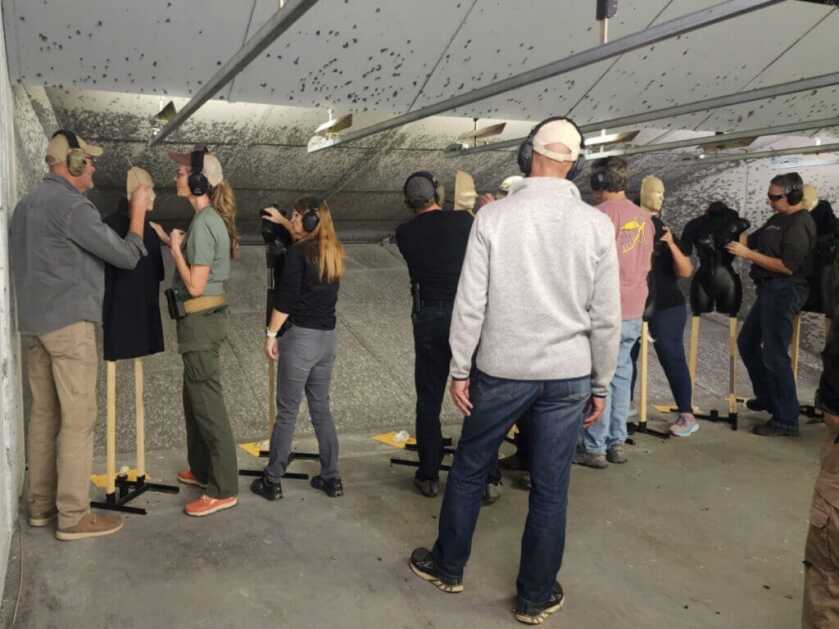Estimated reading time: 0 minutes
A fair amount of legal terminology is thrown around during a self-defense case (and criminal cases in general). Maybe you’ve never stopped to wonder what certain phrases mean, but it’s a good idea to make sure you have a general understanding of it all. Why? As someone who carries a firearm for defensive purposes, you could find yourself in a situation where those terms apply. Also, some legalese can be used to explain certain factors that come into play with self-defense. We’re going to break down some of the most common phrases for you here. Welcome to the world of legal terminology and how it could one day impact your life.

Table of contents
Do I Need to Know Legal Terminology for Self-Defense?
Yes, you should have at least a basic grasp of legal terminology if you’re interested in self-defense. Carrying a firearm to defend your life comes with certain responsibilities, and one of those is knowing the law and how it works—and understanding that laws and regulations vary by state. This is because you can break down the law into two types: federal and state. There’s indeed more to the levels and types of law than only federal and state, but those are the two we’re focusing on.
State laws are created and implemented at the state level, meaning they apply within the state itself. Federal laws are created at the federal level which means they apply to the entire country, not just one part of it. And before you ask if state laws can override federal laws, let’s take a side trip to address that.
The Supremacy Clause is a provision to the U.S. Constitution. It’s a major part of constitutional law and can be found in Article VI, Clause 2. It says:

“This Constitution, and the Laws of the United States which shall be made in Pursuance thereof; and all Treaties made, or which shall be made, under the Authority of the United States, shall be the supreme Law of the Land; and the Judges in every State shall be bound thereby, any Thing in the Constitution or Laws of any State to the contrary not withstanding.”
What this means is that federal laws supersede state laws. This can be important to understand as a firearm owner. Court battles over suppressors are a good example of this. That said, the terminology we’re checking out generally covers legal concepts and standards, not laws.
Available on GunsAmerica Now

What Is the Reasonable Person Standard?
One of the most common legal standards you’ll hear applied to self-defense cases is the reasonable person standard. The person being referenced is fictitious. The reasonable person standard asks if any reasonable person would have acted as you did under the same circumstances, and with the same knowledge you had at that time. So, who decides what’s reasonable? Sounds sort of subjective, right?
Thanks to Vaughn v. Menlove, a case way back in 1837, we know that the reasonable person standard is considered objective rather than subjective. How does that work? Common sense comes into play, but so do the life experiences of members of the jury. That’s right, in many—if not most—cases, it will be the so-called jury of your peers deciding if your actions pass this test. That might sound good, but it gets more iffy when you realize how unusual it is to find someone well-versed in the realities of violence and self-defense sitting on a jury. This is why it’s your attorney’s job—and your job—to educate the jury in a relatable way, but that’s a story for another day.
Let’s consider an extreme example. If someone cuts in front of another person in line at the grocery store, and the person who was cut off responds with lethal force, is that reasonable? Clearly, it’s not, right? Probably not—but what about the circumstances? What if there’s more than meets the eye to this case, and the individual who cut someone off did so while wielding a weapon in a threatening manner? This is why you must also consider the totality of the circumstances.
What Is the Totality of the Circumstances?
The totality of the circumstances is the test by which the legal system—whether it is, at that moment, a judge, jury, or whatever—takes into consideration all the factors of a case. Basically, this means the contributing factors must be taken into consideration, but there’s a catch of sorts. The totality of the circumstances can’t include things not known to you at the time. Maybe the attacker was a fifth-degree black belt, but that wasn’t something you knew at the time of the assault. That means it isn’t included—when you don’t know something, it’s not a contributing factor.
This one’s used beyond criminal law and it’s important to understand how it works. Everything from the weather to tone of voice to prior conflicts comes into play. And as you probably guessed, it has a strong connection to the reasonable person standard.
One factor that can be found in the totality of the circumstances has to do with whether one person involved had a significant advantage over the other. Was the attacker a big, muscular man going after a woman? Maybe a teenager standing over someone on the ground? There’s a lot that goes into this next one.

What Is “Disparity of Force” in Self-Defense?
At its most basic definition, disparity of force refers to a situation where one person—typically the attacker—has an advantage over the person they’re attacking. There’s more to this than it first appears. The general public tends to see a self-defense case and see it in a rather cut-and-dry manner. Good guy, bad guy—and they often automatically see the bad guy as the one left standing, which isn’t great for firearms owners defending their lives.
This is especially true in cases where both people involved are male or where one has a firearm and the other “only had a knife” or appeared not to have a weapon at all. But what if the public had a deeper understanding of the disparity of force?
Look A Little Deeper
The disparity of force goes beyond one party being bigger than the other. It includes factors like how many attackers there are, the age of those involved, pre-existing injuries and illnesses, height, weight, gender, weapons—it’s a long list.
When one party has some sort of advantage, it creates that disparity between the parties, whether it’s readily obvious to outsiders or not (this circles back to the totality of the circumstances and what you knew at that moment). The George Zimmerman case is a famous example. Who do you think had the advantage when Zimmerman was pinned on the ground having his skull beat into the pavement? There are a lot of things to keep in mind, but at that moment, it was Zimmerman who had the disadvantage.
Do you have a back injury that could result in your being crippled if the attacker knocks you down? Are you elderly with less strength and balance? Is your attacker strong enough to swing that branch hard enough to deliver a maiming or killing blow? When you’re looking at a self-defense case, you have to step back and consider everything.
What Is a Credible Threat?
When you’re considering whether someone is a credible threat, you need to include the factors listed above. One detail alone might not make it clear, but when you consider the totality of the circumstances and find a disparity of force, it might become obvious that a reasonable person would utilize potentially lethal force in that situation (yes, that was a mouthful).
Credible threats refer to actions or statements that make it clear the person issuing said threats is a danger. Is someone playing Monopoly and laughing while they say “I’ll kill you!” a credible threat? Probably not. However, is someone saying “I’ll kill you!” as they reach inside their jacket a credible threat? Good chance they are. There’s one more thing, though. It must be an immediate, credible threat, meaning the person in question is ready, willing, and able to cause serious harm. If the person verbally threatens you and you simply walk away, then you go back the next day with a firearm to handle the threat from the day before, is that immediate? No, it is not.
Read More: The California Sig P365…Opening a Door to Concealed Carriers
What Are Ability, Opportunity, and Jeopardy?
AOJ—ability, opportunity, jeopardy—are the factors involved in a potential assailant’s desire and ability to injure or kill. Do they have the ability to do it—maybe a weapon or the physical means to do so? Do they have the opportunity, as in are they actually in a position to carry out the attack? And for jeopardy, it applies to manifest intent, meaning whether the person in question is making it clear they intend to attack. This is a topic that requires a deep dive, but let’s keep it simple today.
These three elements must be present in a self-defense case. You can’t leave one out and think it’s still going to be considered a reasonable action to draw your firearm and take a shot. For example, there can be ability and opportunity without jeopardy. You, yourself, are a fantastic example. You’re sitting there with a holstered firearm, surrounded by people. Do you have the ability and opportunity to harm? Yes. But are you doing it? Is there any jeopardy? No, there is not. This is a bit of an oversimplification, but you get the idea.
Final Thoughts
There’s a lot of terminology beyond these, but this gives you a general overview. If you want to learn more, consider getting yourself a copy of Black’s Law Dictionary. Taking Massad Ayoob’s MAG-40 class is also a good foundation for starting to get a better understanding of self-defense law.
*** Buy and Sell on GunsAmerica! ***












Nice run down on the basics! The only addition I would add is that the person claiming self defense cannot have been an initiator or instigator of a physical conflict with the assailant.